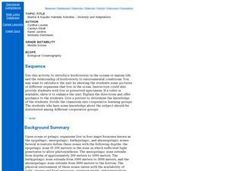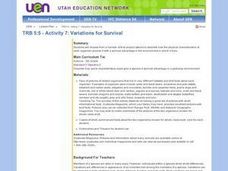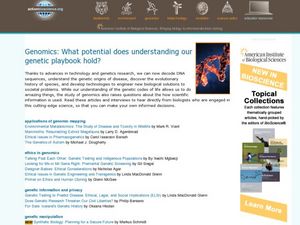Curated OER
Communicable Diseases
In this communicable diseases worksheet, students explain what causes most types of diseases. Then they describe the difference between a disinfectant and an antiseptic. Students also determine ways that communicable diseases can be spread.
Curated OER
Cell Structure And Function
In this biology worksheet, students respond to 13 multiple choice questions related to cell structure and function. They identify which are microfilamets and which have a cell wall. Students also describe what chloroplasts are and their...
Curated OER
Water: H2O = Life
In this earth science worksheet, students explore and describe animals and their adaptations, including their habitats, physical characteristics, and competing organisms. They also explore and describe how others use water around the...
Curated OER
Population Density
Middle schoolers use the scientific method to conduct an experiment and use varied methods to gather background information. They correctly use lab equipment and prepare tables and graphs that organize, conclude, and present their...
Curated OER
ARE WE IN THE MIDDLE OF A MASS EXTINCTION?
Students identify and interpret the following: What is mass extinction, and what are some theories for why it happens? How often do species become extinct? What is the normal rate of extinction? Why are some species endangered? What...
Curated OER
Marine & Aquatic Habitats Activities - Habitats of Birds, Fish, and Mammals on the Island and the Pacific Region
Students create habitats in jars to understand integral aspects of plants' and animals' habitats.
Curated OER
Marine & Aquatic Habitats Activities - Diversity and Adaptations
Students analyze biozones and how to identify and diagram them. They also research which organisms can adapt to different biozones.
Curated OER
Variations for Survival
Fifth graders examine two related organisms that live in different environments and compare how the physical characteristics of each organism provided it with survival advantages unique to its own environment.
Curated OER
Everything in Its Place: Science Classification
Students investigate the system of classification for living things through the sixteen lessons of this unit. The five kingdoms of monerans, protists, fungi, plants, and animals form the basis of several experiments as the similarities...
Curated OER
Pond Water Survey
In this survey worksheet students complete a series of short answers to questions on data collection, volume and populations of organisms.
Curated OER
Food Chains and Webs
Students identify the organisms found near their school or house and observe them. In this food chain instructional activity students examine how an organism gets their energy and then fill in a chart to create a food web with the...
Curated OER
Minnesota Ecosystems
Students study the different ecosystems found in Minnesota. In this ecosystem lesson students complete a worksheet on climate and the major organisms found in Minnesota.
Curated OER
Issues in Genomics
Students explore the definition of ethics and genomics. In this organism lesson students participate in the chosen teacher lesson.
Curated OER
Genetic Variation
Students study families and their genetics. In this investigative lesson students explain how variations in genetics can be harmful and how some can help with survival.
Curated OER
The Living Environment
Ninth graders compare and contrast animals according to their four systems. For this living environment lesson students complete their assignment on the animal they were given and present their findings to the class.
Curated OER
Super Scientists Code
In this science worksheet, students use the key code on the right to unscramble each of the scientists. They also match each of the scientists found to their correct description.
Curated OER
Classifying Living Things Wordsearch
In this biology worksheet, students locate and identify various vocabulary terms related to classifying living things. There are 24 biology terms located in the word search.
Curated OER
Ecosystems and Symbiotic Relationships
Students are told to create a community using words or pictures. They walk outside to an area in front of the school which has a strip of grass, ditch, and corn field. Students discuss the difference between an ecosystem and a...
Curated OER
Mussel Identification Activity
Learners identify given species of animals, such as various
mussels, by sets of physical characteristics as they use a key. They also read about mussels on the Illinois River and look at mussel species in the online database. Finally,...
Curated OER
Food Webs
Students are explained that they are spending the next few days researching an organism in preparation for a field trip. They are shown an overhead of the Field Guide. Students discuss what habitat means. They use their organism to...
Curated OER
Identifying trophic levels and the skeletal system through Owl Pellets
Students identify a food chain sequence. They compare, identify, and record the rodent skeletal parts to a rodent skeletal diagram. Students construct a rodent skeleton from the skeletal parts found in the pellet. They are given the...
Curated OER
SIM Ecosystem
Students identify and interpret the concept of an ecosystem and the potential impact humans have on ecosystems. They also proficient in organized and methodical Internet searches. Finally, students become proficient with public...
Curated OER
The Tank
Middle schoolers have a better grasp of the ecosystem of the St. Mary's river. They analyze how the tank is meant to be a miniature of the river. Students inquire how to take care of the tank and its inhabitants. They are introduced to...
Curated OER
You Belong in the Zoo Project - Using HyperStudio
Students explore the diversity of living organisms. They research an animal found in the zoo and plans a 10-card HyperStudio project about his/her organism.

























